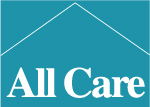February is Healthy Heart month and All Care is pleased to publish a 4-part blog series about heart disease, its effects, warning signs, and how to incorporate healthy habits to increase the health of your heart.
Part I: What is Heart Disease?
 Heart disease is an umbrella term for any type of disorder that affects the heart. Heart disease means the same as cardiac disease but not cardiovascular disease. Cardiovascular disease refers to disorders of the blood vessels and heart, while heart disease refers to just the heart.
Heart disease is an umbrella term for any type of disorder that affects the heart. Heart disease means the same as cardiac disease but not cardiovascular disease. Cardiovascular disease refers to disorders of the blood vessels and heart, while heart disease refers to just the heart.
Here are some common types of heart disease that you may have heard of:
Arrhythmia – an irregular heartbeat. Arrhythmias are problems with the heart rhythm which happens when the heart’s electrical impulses that coordinate heartbeats don’t work properly, resulting in the heart beating too fast, too slow, or erratically. While irregular heartbeats are common (we all have them at some point, they feel like a fluttering or racing heart) but when they veer too far from a normal heart beat because of a damaged or weak heart, they need to be taken seriously and treated by a doctor as they can sometimes be fatal.
- Tachycardia is when the heart beats too fast
- Bradycardia is when the heart beats too slowly
- Premature contraction is when the heart beats too early
- Fibrillation is when the heart beat is irregular
Congenital heart disease – this is a general term for some birth defects that affect how the heart works. Congenital means you are born with it. Examples include:
- Septal defects – there is a hole between the two chambers of the heart. This condition is sometimes called hole in the heart.
- Obstruction defects – the flow of blood through various chambers of the heart is partially or even totally blocked
- Cyanotic heart disease – not enough oxygen is pumped around the body because there is a defect (or some defects) in the heart.
Coronary artery disease – the coronary arteries, which supply the heart with nutrients, oxygen and blood become diseased or damaged, usually because of plaque deposits (cholesterol-containing deposits). Plaque accumulation narrows the coronary arteries and the heart gets less oxygen.
Myocardial infarction – also known as heart attack, cardiac infarction and coronary thrombosis. Interrupted blood flow (lack of oxygen) damages or destroys part of the heart muscle. This is usually caused by a blood clot that develops in one of the coronary arteries (blood vessels that supply the heart with blood). It can also occur if an artery suddenly narrows (spasm).
Heart failure – also known as congestive heart failure. The heart does not pump blood around the body efficiently. The left or right side of the body might be affected; sometimes both sides are. Coronary artery disease or hypertension (high blood pressure) can over time leave the heart too stiff or weak to fill and pump properly.
Come back to read the second installment of our Healthy Heart Series to learn about the warning signs of heart disease, prevention, and control.
